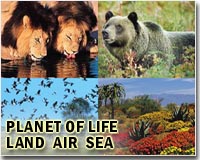 |
Rio De Janeiro (AFP) March 18, 2011 A new rodent living in treetops was discovered recently in the Atlantic Forest, one of Brazil's most-ravaged ecosystems, according to a published report Friday. The foot-long creature, referred to as a white-spotted mountain rat or "Drymoreomys albimaculatus," lives at an altitude of 3,280 feet (1,000 meters) in mountain ranges in southeast Brazil, biologist Alexandre Percequillo told Folha de Sao Paulo newspaper. "An evolutionary mystery hangs over this rodent species because the closest species to him lives in an arid valley of the Peruvian Andes," said Percequillo, a researcher with the University of Sao Paulo who described the new species in the Zoological Journal of the Linnean Society. "The fact that both species belong to groups typical of mountain regions may explain their similarity," Percequillo said. The rodent has "pads" on the bottom of its feet and between its fingers, allowing it to negotiate tree branches, from which it hangs. It is too early to determine if the species is threatened by extinction, according to Percequillo. The Atlantic Forest, which at one time covered 15 percent of Brazil, has been greatly reduced. Its destruction is blamed on urbanization, farming and logging, among other things.
Share This Article With Planet Earth
Related Links Darwin Today At TerraDaily.com
 Scientist: Moving species could save them
Scientist: Moving species could save themYork, England (UPI) Mar 17, 2011 A radical program of "assisted colonization" could save species endangered by climate change, a U.K. researcher says, proposing Britain as one destination. Chris Thomas, a professor of conservation biology at the University of York, says the strategy is applicable across the world. He suggests Britain as a potential haven for species such as the Iberian lynx, the Spanish Imperial Eagle, ... read more |
|
| The content herein, unless otherwise known to be public domain, are Copyright 1995-2010 - SpaceDaily. AFP and UPI Wire Stories are copyright Agence France-Presse and United Press International. ESA Portal Reports are copyright European Space Agency. All NASA sourced material is public domain. Additional copyrights may apply in whole or part to other bona fide parties. Advertising does not imply endorsement,agreement or approval of any opinions, statements or information provided by SpaceDaily on any Web page published or hosted by SpaceDaily. Privacy Statement |